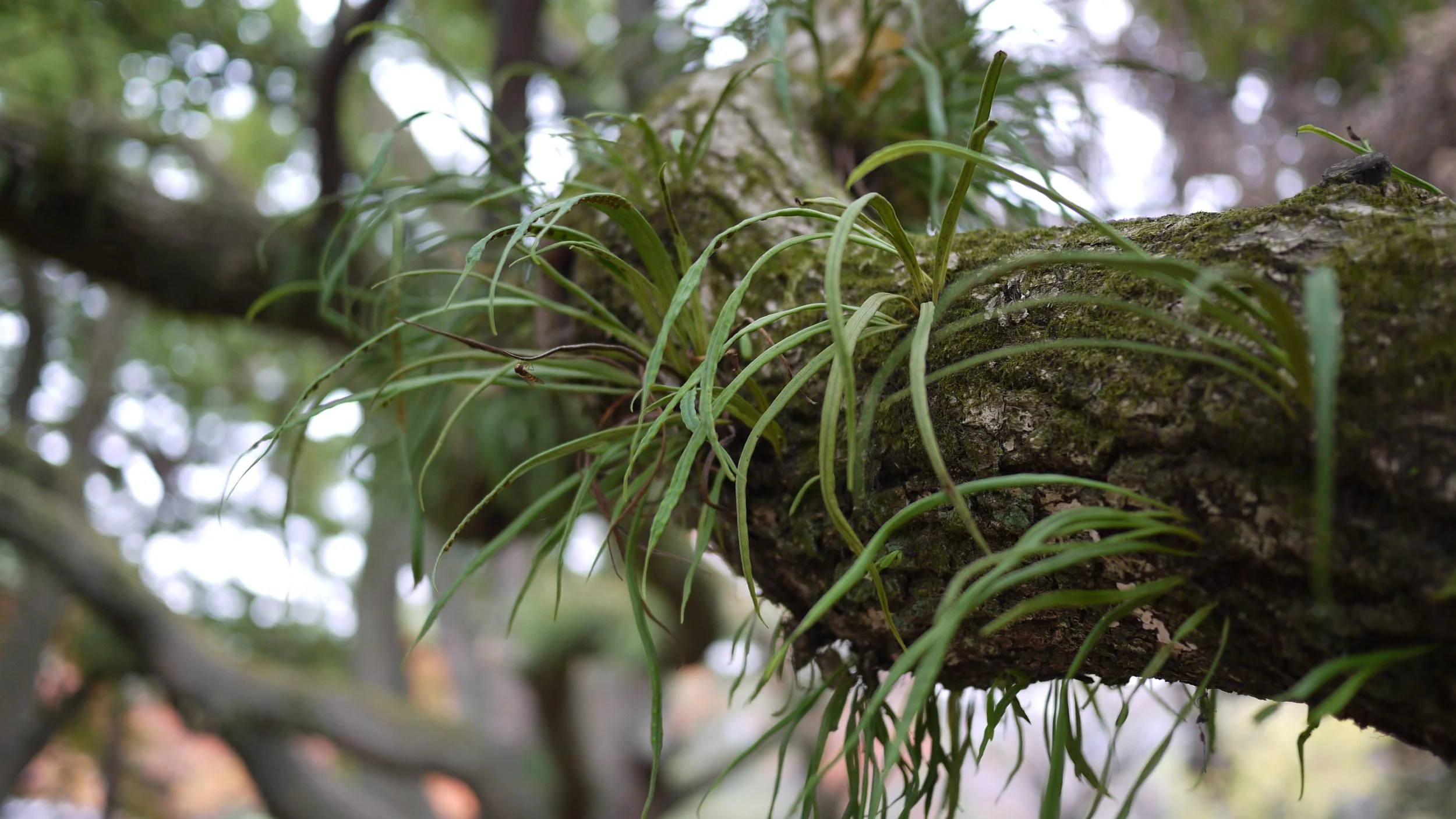The Verdant Heart of the Atlantic Coast
An initial research image of a temperate rainforest zone made in Borrowdale, Cumbria. 2021.
As mentioned previously, my main projects of 2023 focus on geology in Wales, and the forests of Britain’s western seaboard.
I began researching the latter after coming across epiphytic grasses growing from a tree in a primeval forest in Nara, Japan, in 2009. Most of Japan’s central and western landmass exists within a ‘temperate zone’ - an area in which rainfall, humidity and annual temperatures combine to create ideal conditions for year-round verdant growth. Temperate forest zones are characterised by an abundance of moss, ferns, lichens, and larger epiphytic plants (plants which grow on other plants, without parasitism).
Nara’s primeval forests carry an inherently profound atmosphere; a sense of place that exists almost outside of human realms, evoking deep feelings of reverence and a sense that a great unseen is present. This isn’t an undiscovered aspect of Japanese culture - in Japan, the indigenous ‘way’ of Shintō - animism, spirit and nature worship - has existed in some form since the Yayoi period (named distinctly since 200 BCE, nameless yet existing likely thousands of years before this time). Therefore, the idea of ‘human worlds’ and ‘spirit worlds’ has been long since established, as has the idea that certain parts of the human and spirit worlds share blurred boundaries.¹ Primeval forests are key areas in which Shintō practice takes place.
Nara’s ‘hairy’ trees, 2010.
Japan’s primeval forests moved me profoundly; they are unforgettable places, rich in an intense and inexplicable kind of power; a sense that the air itself is vibrating, bending and sighing under the weight of living things. What I didn’t expect was that similar places existed right on my doorstep, in Britain.
Although the most impactful examples of temperate rainforests exist in the Pacific Northwest of the United States and in Canada (British Columbia, Oregon and Washington), Britain has its own scaled-down versions; made dainty for our small island, but no less old or breathtaking. After further research, I learned that before the proliferation of Neolithic and Bronze Age settlers, great swathes of the British Isles were carpeted with this unique, primordial ecosystem, established after the great land-abrasion of the last Ice Age. A warmer, damper time would have seen a landscape thick and spongey with emerald mosses, dripping with lichens and hazed with carpets of shimmering ferns. But what had happened? Why are these forests now so scarce that most people don’t know they exist?
The great denuding of Britain’s landscape is a long story. Bronze Age settlers would have deforested lands for animal grazing and for timber. Grazing and pasture have been responsible for the wholesale destruction of much of Britain’s Atlantic oakwoods, and are largely responsible for preventing its regeneration. Arable and animal agriculture, intensive farming and deforestation for timber industries have all played their part; it will take individuals, corporate bodies and entire industries to affect the fate of the forests.
Research image made in Borrowdale, Cumbria, 2021.
Much of the temperate rainforest that remains sits in un-farmable, vehicle-inaccessible valleys. For this reason alone, these deep green fragments of primeval woodland persist, but are still threatened by the intensive grazing of sheep. Nibbling all greenery down to a hard skin of felt, sheep (directed by humans) prevent the regenerative process of succession, from which brackens, hazel, rowan and holly saplings rise before giving way to oak, soaked in moss and lichen. Anyone who has visited Dartmoor, Exmoor or the Lake District will be familiar with the sight of hills and mountains shaved almost down to the bone by grazing. While majestic sights in their own bald right, these hills are naturally capable of supporting far more than scrub and ewes.
Woodland, especially woodland rich in bryophytes (moss) and epiphytes are exceptional carbon sinks, capable of drawing significant quantities of CO2 from the atmosphere and sequestering it in wood and humus. As flood prevention, a hillside rich in dense plant matter absorbs flood-rain, instead of allowing it to gush across bare rocks and into inhabited valleys. The biodiversity of natural, primeval woodlands (as opposed to plant-for-harvest timber farms) is one of the richest and most varied within the British landscape.
And yet, vanishingly little is publicly known about temperate rainforests and Atlantic oakwoods. However, in recent years, a surge of interest in these unique habitats has led to both scientific and vernacular research and documentation.
In 2022, British author Guy Shrubsole released ‘The Lost Rainforests of Britain’, a book born of his campaign of the same name. Both The Woodland Trust and PlantLife have created awareness campaigns and won funding to protect and restore temperate rainforests and Atlantic oakwoods in the West of England, and Scotland is home to an entire Rainforet Alliance.
Although my initial documentation of temperate rainforests in Japan began in 2009, I have continued, since returning to the UK in 2019, to gather information informing the conditions of Britain’s temperate rainforests. With the research experience and project development skills I have fostered during my Master’s Photography degree at UWE, I now have the confidence to begin a longer-term project examining both the ecological and metaphysical overviews of Britain’s temperate rainforests.
Research image made in Borrowdale, Cumbria, 2021.
¹While the ‘Yamato’ ethnicity of mainland Japan practice Shintō, the indigenous Ainu populations of the northern island of Hokkaidō have similar belief systems dating as far back as the Jōmon period (10,000 BCE). “Ainu Mosir” [eye-noo mo-shee-ree] is the ‘Land of the Humans.’ “Kamuy Mosir” [kah-moo-ee mo-shee-ree] is the ‘Land of the Spirits.’ All things could be imbued with ‘Kamuy’ - rocks, rivers, trees, mountains, animals and humans.



